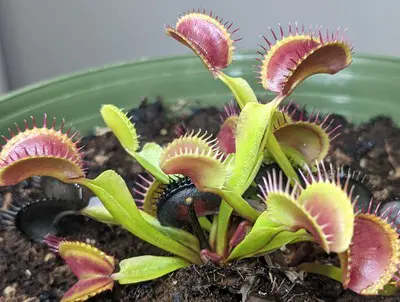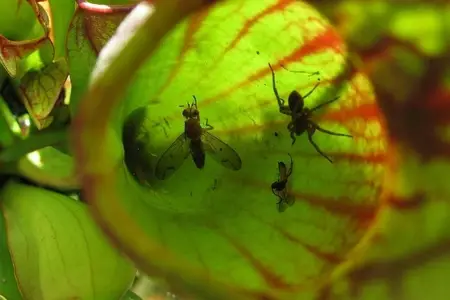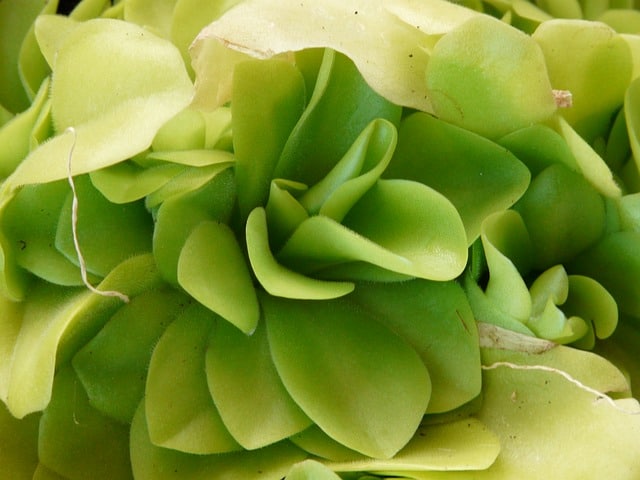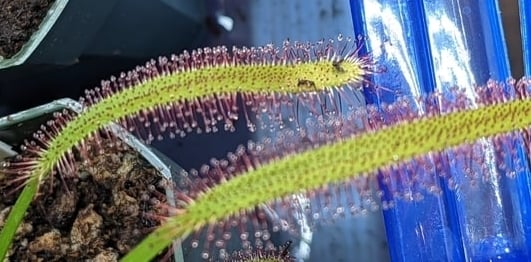Venus fly traps use their traps to capture any bug that fits inside their traps. Some usual prey include flies, ants, spiders, and gnats.
Can Venus fly trap help you control the flies population? Yes, but in a limited fashion.
Venus fly traps usually have 5-7 leaves at a time. Each leaf can capture one fly at a time every 2-6 weeks. So, an adult plant could get rid of around 10 flies a month, assuming it captures a new prey right after finishing the previous.

In order to maximize pest control efficiency, you can follow these tips:
- Use adult plants: Seedlings or young Venus fly traps have tiny traps unable to capture and adult fly and will take years to grow into a more mature size.
- Place your Venus fly traps close to the source: Venus fly traps produce sweet nectar to lure insects. However, the reach of such nectar is not extensive. The bug needs to be close by to notice the scent and possibly become your plant’s food.
- Consider employing multiple plants at a time: Several Venus fly traps can be potted in the same pot to help as pest control.
- Research about Venus fly trap care before getting started: Venus fly traps require specific water, soil, and care to survive. Before committing to use them as pest control, learn about the difficulty of keeping them alive. Here is a quick overview on the subject: How To Grow Venus Fly Trap – Difficulty: Moderate Level
Disclaimer: Venus fly traps won’t cause a bug problem in your home by attracting bug. Instead, they will attempt to capture the insects in close proximity.
In short, Venus fly traps won’t get rid of a pest infestation, but can help capture the occasional fly. However, some other carnivorous plants are a lot more effective controlling flies or tiny gnats. Here are some great options!
Pitcher Plants: The Best Carnivorous Plants to Reduce Flies
These plants characterize by pitcher-like structures that attract bugs. Sweet scents lure bugs. If the victim slips inside the trap, slippery surfaces prevent the bug from escaping.
Pitcher plants can capture dozens of bugs at a time in each pitcher, and they have multiple pitchers ready to capture pests.

Pitcher plants are an exceptionally beautiful and interesting family of plants to grow and care for. The very nature of a carnivorous plant begs your attention, and they are interesting to watch as they grow and feed. However, they can be considered to have a certain level of difficulty in growing.
All pitcher plants require extensive periods of sunlight or artificial lighting of over 10 hours a day, a humid environment, pure mineral-free water, carnivorous plant soil, and sometimes a dormancy period (similar to hibernation)
Sarracenia varieties require tons of sunlight, and won’t thrive indoors. They can serve to control pests out doors or in a greenhouse, but not as indoors pest control.
The tropical Nepenthes variety tends to be more forgiving and can live in a temperate indoor climate year-round.
Learn more about pitcher plants and their care by reading my guide: How to Care for Pitcher Plants – Growing Guide
The Best Carnivorous Plants to Reduce Gnats and Mosquitoes
There are two carnivorous plants that are built perfectly for capturing tiny flying insects: Butterworts and Sundews
Butterworts
Butterworts or Mexican butterworts have sticky leaves with strong adhesives for insects. As insects walk through the leaves or land in one, they get stuck.
When bugs attempt to fight their way out of the adhesive surface, they get stuck more and more.
All the leaves within the plant are capable of capturing and digesting prey. The only factor that limits how many bugs get stuck to the plant is the plant’s size.
Butterworts are great for controlling gnats, fruit flies, ants, and other smaller bugs.

Sundews
These plants also employ their adhesive leaves to capture bugs.
Bugs that get stuck to the leaves of the plant end up becoming food. The insects remain in the leaf while the plant covers them with digestive enzymes. Mature Sundews can capture more prey and larger bugs due to their size.

This was a general overview, but if you are serious about using carnivorous plants as pest control, read this article .
.
Where to Buy Carnivorous Plants
The five most common places where you can buy carnivorous plants are specialized online shops, brick-and-mortar stores, local shops, and Amazon and Etsy.
Walmart, Trader Joe’s, Kroger, Home Depot, and several big box stores will seasonally carry the standard variety of Venus fly traps and sometimes types of pitcher plants. They usually sell for about $5-15 dollars.
Online shops specializing in carnivorous plants offer beautiful specimens and different varieties of sundews, venus fly traps, pitcher plants, and more.
Here are a few good shop options:
